+ Open data
Open data
- Basic information
Basic information
| Entry | Database: PDB / ID: 6ro4 | |||||||||||||||
|---|---|---|---|---|---|---|---|---|---|---|---|---|---|---|---|---|
| Title | Structure of the core TFIIH-XPA-DNA complex | |||||||||||||||
 Components Components |
| |||||||||||||||
 Keywords Keywords | TRANSLOCASE / Complex / Helicase / DNA repair | |||||||||||||||
| Function / homology |  Function and homology information Function and homology informationnucleotide-excision repair factor 1 complex / nucleotide-excision repair involved in interstrand cross-link repair / nucleotide-excision repair, DNA damage recognition / MMXD complex / core TFIIH complex portion of holo TFIIH complex / Cytosolic iron-sulfur cluster assembly / central nervous system myelin formation / positive regulation of mitotic recombination / hair cell differentiation / hair follicle maturation ...nucleotide-excision repair factor 1 complex / nucleotide-excision repair involved in interstrand cross-link repair / nucleotide-excision repair, DNA damage recognition / MMXD complex / core TFIIH complex portion of holo TFIIH complex / Cytosolic iron-sulfur cluster assembly / central nervous system myelin formation / positive regulation of mitotic recombination / hair cell differentiation / hair follicle maturation / nucleotide-excision repair factor 3 complex / nucleotide-excision repair, preincision complex assembly / CAK-ERCC2 complex / UV protection / embryonic cleavage / DNA 5'-3' helicase / G protein-coupled receptor internalization / transcription factor TFIIH core complex / transcription factor TFIIH holo complex / UV-damage excision repair / transcription preinitiation complex / RNA Polymerase I Transcription Termination / regulation of mitotic cell cycle phase transition / DNA 3'-5' helicase / RNA polymerase II general transcription initiation factor activity / transcription factor TFIID complex / 3'-5' DNA helicase activity / erythrocyte maturation / hematopoietic stem cell proliferation / spinal cord development / RNA Pol II CTD phosphorylation and interaction with CE during HIV infection / RNA Pol II CTD phosphorylation and interaction with CE / HIV Transcription Initiation / RNA Polymerase II HIV Promoter Escape / Transcription of the HIV genome / RNA Polymerase II Promoter Escape / RNA Polymerase II Transcription Pre-Initiation And Promoter Opening / RNA Polymerase II Transcription Initiation / RNA Polymerase II Transcription Initiation And Promoter Clearance / Formation of the Early Elongation Complex / Formation of the HIV-1 Early Elongation Complex / bone mineralization / mRNA Capping / ATPase activator activity / DNA topological change / intrinsic apoptotic signaling pathway by p53 class mediator / RNA Polymerase I Transcription Initiation / protein localization to nucleus / hematopoietic stem cell differentiation / embryonic organ development / positive regulation of transcription initiation by RNA polymerase II / Tat-mediated elongation of the HIV-1 transcript / Formation of HIV-1 elongation complex containing HIV-1 Tat / transcription elongation by RNA polymerase I / Formation of HIV elongation complex in the absence of HIV Tat / response to UV / RNA Polymerase II Transcription Elongation / Formation of RNA Pol II elongation complex / transcription-coupled nucleotide-excision repair / RNA Polymerase II Pre-transcription Events / extracellular matrix organization / DNA helicase activity / insulin-like growth factor receptor signaling pathway / maturation of SSU-rRNA from tricistronic rRNA transcript (SSU-rRNA, 5.8S rRNA, LSU-rRNA) / post-embryonic development / determination of adult lifespan / nucleotide-excision repair / chromosome segregation / TP53 Regulates Transcription of DNA Repair Genes / transcription initiation at RNA polymerase II promoter / transcription elongation by RNA polymerase II / RNA Polymerase I Promoter Escape / promoter-specific chromatin binding / cellular response to gamma radiation / base-excision repair / NoRC negatively regulates rRNA expression / Dual Incision in GG-NER / response to toxic substance / Transcription-Coupled Nucleotide Excision Repair (TC-NER) / Formation of TC-NER Pre-Incision Complex / spindle / Formation of Incision Complex in GG-NER / multicellular organism growth / Dual incision in TC-NER / intrinsic apoptotic signaling pathway in response to DNA damage / Gap-filling DNA repair synthesis and ligation in TC-NER / sequence-specific double-stranded DNA binding / intracellular protein localization / 4 iron, 4 sulfur cluster binding / response to oxidative stress / double-stranded DNA binding / 5'-3' DNA helicase activity / protein-macromolecule adaptor activity / in utero embryonic development / damaged DNA binding / transcription by RNA polymerase II / response to hypoxia / regulation of autophagy / nuclear speck / nuclear body Similarity search - Function | |||||||||||||||
| Biological species |  Homo sapiens (human) Homo sapiens (human) | |||||||||||||||
| Method | ELECTRON MICROSCOPY / single particle reconstruction / cryo EM / Resolution: 3.5 Å | |||||||||||||||
 Authors Authors | Kokic, G. / Chernev, A. / Tegunov, D. / Dienemann, C. / Urlaub, H. / Cramer, P. | |||||||||||||||
| Funding support |  Germany, 4items Germany, 4items
| |||||||||||||||
 Citation Citation |  Journal: Nat Commun / Year: 2019 Journal: Nat Commun / Year: 2019Title: Structural basis of TFIIH activation for nucleotide excision repair. Authors: Goran Kokic / Aleksandar Chernev / Dimitry Tegunov / Christian Dienemann / Henning Urlaub / Patrick Cramer /  Abstract: Nucleotide excision repair (NER) is the major DNA repair pathway that removes UV-induced and bulky DNA lesions. There is currently no structure of NER intermediates, which form around the large ...Nucleotide excision repair (NER) is the major DNA repair pathway that removes UV-induced and bulky DNA lesions. There is currently no structure of NER intermediates, which form around the large multisubunit transcription factor IIH (TFIIH). Here we report the cryo-EM structure of an NER intermediate containing TFIIH and the NER factor XPA. Compared to its transcription conformation, the TFIIH structure is rearranged such that its ATPase subunits XPB and XPD bind double- and single-stranded DNA, consistent with their translocase and helicase activities, respectively. XPA releases the inhibitory kinase module of TFIIH, displaces a 'plug' element from the DNA-binding pore in XPD, and together with the NER factor XPG stimulates XPD activity. Our results explain how TFIIH is switched from a transcription to a repair factor, and provide the basis for a mechanistic analysis of the NER pathway. | |||||||||||||||
| History |
|
- Structure visualization
Structure visualization
| Movie |
 Movie viewer Movie viewer |
|---|---|
| Structure viewer | Molecule:  Molmil Molmil Jmol/JSmol Jmol/JSmol |
- Downloads & links
Downloads & links
- Download
Download
| PDBx/mmCIF format |  6ro4.cif.gz 6ro4.cif.gz | 464.1 KB | Display |  PDBx/mmCIF format PDBx/mmCIF format |
|---|---|---|---|---|
| PDB format |  pdb6ro4.ent.gz pdb6ro4.ent.gz | 363.2 KB | Display |  PDB format PDB format |
| PDBx/mmJSON format |  6ro4.json.gz 6ro4.json.gz | Tree view |  PDBx/mmJSON format PDBx/mmJSON format | |
| Others |  Other downloads Other downloads |
-Validation report
| Summary document |  6ro4_validation.pdf.gz 6ro4_validation.pdf.gz | 826.6 KB | Display |  wwPDB validaton report wwPDB validaton report |
|---|---|---|---|---|
| Full document |  6ro4_full_validation.pdf.gz 6ro4_full_validation.pdf.gz | 851.6 KB | Display | |
| Data in XML |  6ro4_validation.xml.gz 6ro4_validation.xml.gz | 65.1 KB | Display | |
| Data in CIF |  6ro4_validation.cif.gz 6ro4_validation.cif.gz | 99.6 KB | Display | |
| Arichive directory |  https://data.pdbj.org/pub/pdb/validation_reports/ro/6ro4 https://data.pdbj.org/pub/pdb/validation_reports/ro/6ro4 ftp://data.pdbj.org/pub/pdb/validation_reports/ro/6ro4 ftp://data.pdbj.org/pub/pdb/validation_reports/ro/6ro4 | HTTPS FTP |
-Related structure data
| Related structure data |  4970MC M: map data used to model this data C: citing same article ( |
|---|---|
| Similar structure data |
- Links
Links
- Assembly
Assembly
| Deposited unit | 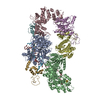
|
|---|---|
| 1 |
|
- Components
Components
-DNA chain , 2 types, 2 molecules JK
| #1: DNA chain | Mass: 15036.663 Da / Num. of mol.: 1 / Source method: obtained synthetically / Source: (synth.)  Homo sapiens (human) Homo sapiens (human) |
|---|---|
| #2: DNA chain | Mass: 15075.698 Da / Num. of mol.: 1 / Source method: obtained synthetically / Source: (synth.)  Homo sapiens (human) Homo sapiens (human) |
-Protein , 3 types, 3 molecules ABG
| #3: Protein | Mass: 89404.734 Da / Num. of mol.: 1 Source method: isolated from a genetically manipulated source Source: (gene. exp.)  Homo sapiens (human) / Gene: ERCC3, XPB, XPBC / Production host: Homo sapiens (human) / Gene: ERCC3, XPB, XPBC / Production host:  Trichoplusia ni (cabbage looper) / References: UniProt: P19447, DNA helicase Trichoplusia ni (cabbage looper) / References: UniProt: P19447, DNA helicase |
|---|---|
| #5: Protein | Mass: 87021.078 Da / Num. of mol.: 1 Source method: isolated from a genetically manipulated source Source: (gene. exp.)  Homo sapiens (human) / Gene: ERCC2, XPD, XPDC / Production host: Homo sapiens (human) / Gene: ERCC2, XPD, XPDC / Production host:  Trichoplusia ni (cabbage looper) / References: UniProt: P18074, DNA helicase Trichoplusia ni (cabbage looper) / References: UniProt: P18074, DNA helicase |
| #9: Protein | Mass: 31422.053 Da / Num. of mol.: 1 Source method: isolated from a genetically manipulated source Source: (gene. exp.)  Homo sapiens (human) / Gene: XPA, XPAC / Production host: Homo sapiens (human) / Gene: XPA, XPAC / Production host:  Trichoplusia ni (cabbage looper) / References: UniProt: P23025 Trichoplusia ni (cabbage looper) / References: UniProt: P23025 |
-General transcription factor IIH subunit ... , 4 types, 4 molecules FEDC
| #4: Protein | Mass: 8060.362 Da / Num. of mol.: 1 Source method: isolated from a genetically manipulated source Source: (gene. exp.)  Homo sapiens (human) / Gene: GTF2H5, C6orf175, TTDA / Production host: Homo sapiens (human) / Gene: GTF2H5, C6orf175, TTDA / Production host:  Trichoplusia ni (cabbage looper) / References: UniProt: Q6ZYL4 Trichoplusia ni (cabbage looper) / References: UniProt: Q6ZYL4 |
|---|---|
| #6: Protein | Mass: 34416.008 Da / Num. of mol.: 1 Source method: isolated from a genetically manipulated source Source: (gene. exp.)  Homo sapiens (human) / Gene: GTF2H3 / Production host: Homo sapiens (human) / Gene: GTF2H3 / Production host:  Trichoplusia ni (cabbage looper) / References: UniProt: Q13889 Trichoplusia ni (cabbage looper) / References: UniProt: Q13889 |
| #7: Protein | Mass: 44481.996 Da / Num. of mol.: 1 Source method: isolated from a genetically manipulated source Source: (gene. exp.)  Homo sapiens (human) / Gene: GTF2H2, BTF2P44 / Production host: Homo sapiens (human) / Gene: GTF2H2, BTF2P44 / Production host:  Trichoplusia ni (cabbage looper) / References: UniProt: Q13888 Trichoplusia ni (cabbage looper) / References: UniProt: Q13888 |
| #8: Protein | Mass: 52245.156 Da / Num. of mol.: 1 Source method: isolated from a genetically manipulated source Source: (gene. exp.)  Homo sapiens (human) / Gene: GTF2H4 / Production host: Homo sapiens (human) / Gene: GTF2H4 / Production host:  Trichoplusia ni (cabbage looper) / References: UniProt: Q92759 Trichoplusia ni (cabbage looper) / References: UniProt: Q92759 |
-Non-polymers , 2 types, 7 molecules 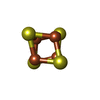


| #10: Chemical | ChemComp-SF4 / |
|---|---|
| #11: Chemical | ChemComp-ZN / |
-Experimental details
-Experiment
| Experiment | Method: ELECTRON MICROSCOPY |
|---|---|
| EM experiment | Aggregation state: PARTICLE / 3D reconstruction method: single particle reconstruction |
- Sample preparation
Sample preparation
| Component |
| ||||||||||||||||||||||||
|---|---|---|---|---|---|---|---|---|---|---|---|---|---|---|---|---|---|---|---|---|---|---|---|---|---|
| Source (natural) |
| ||||||||||||||||||||||||
| Source (recombinant) |
| ||||||||||||||||||||||||
| Buffer solution | pH: 7.5 | ||||||||||||||||||||||||
| Specimen | Embedding applied: NO / Shadowing applied: NO / Staining applied: NO / Vitrification applied: YES | ||||||||||||||||||||||||
| Specimen support | Grid material: GOLD / Grid type: Quantifoil R2/2 | ||||||||||||||||||||||||
| Vitrification | Instrument: FEI VITROBOT MARK IV / Cryogen name: ETHANE / Humidity: 100 % / Chamber temperature: 277 K Details: 4 ul of sample was applied to glow-discharged grids which were blotted for 5s and plunge-frozen in liquid ethane. |
- Electron microscopy imaging
Electron microscopy imaging
| Experimental equipment |  Model: Titan Krios / Image courtesy: FEI Company |
|---|---|
| Microscopy | Model: FEI TITAN KRIOS |
| Electron gun | Electron source:  FIELD EMISSION GUN / Accelerating voltage: 300 kV / Illumination mode: FLOOD BEAM FIELD EMISSION GUN / Accelerating voltage: 300 kV / Illumination mode: FLOOD BEAM |
| Electron lens | Mode: BRIGHT FIELD / Nominal magnification: 130000 X / Cs: 2.7 mm |
| Image recording | Electron dose: 41 e/Å2 / Film or detector model: GATAN K2 SUMMIT (4k x 4k) |
- Processing
Processing
| CTF correction | Type: PHASE FLIPPING AND AMPLITUDE CORRECTION |
|---|---|
| Symmetry | Point symmetry: C1 (asymmetric) |
| 3D reconstruction | Resolution: 3.5 Å / Resolution method: FSC 0.143 CUT-OFF / Num. of particles: 227776 / Symmetry type: POINT |
 Movie
Movie Controller
Controller




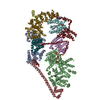
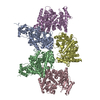
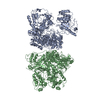
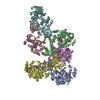


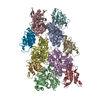
 PDBj
PDBj














































